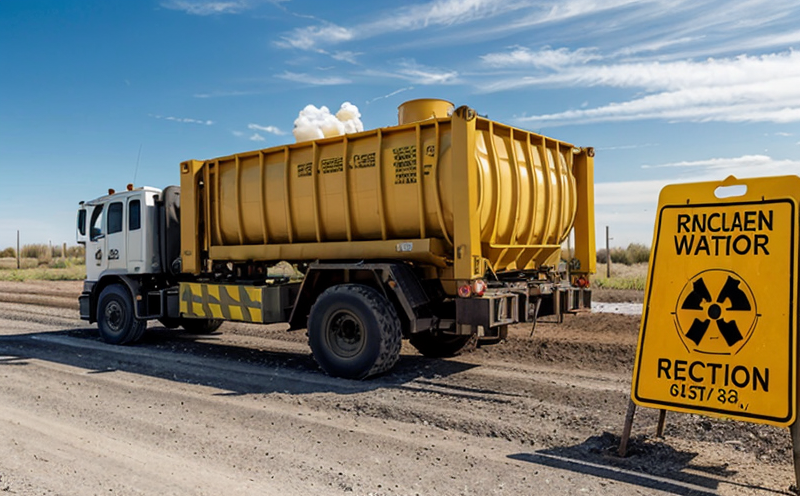ASTM C934 Radiochemistry of Solid Radioactive Waste
The ASTM C934 standard method is widely recognized for its rigorous approach to assessing the radiochemistry of solid radioactive waste. This testing is essential in ensuring that nuclear facilities and regulatory bodies can accurately quantify radionuclides present within solid waste materials. The process involves several critical steps, including sample preparation, dissolution techniques, and subsequent analysis using various spectrometric methods.
Sample preparation plays a crucial role in ASTM C934 testing. Typically, this includes the collection of representative samples from waste streams, followed by thorough drying and crushing to achieve a homogenous mixture suitable for further processing. Dissolution is another key step where samples are dissolved using appropriate solvents compatible with the radionuclides present. This phase ensures that all radioactive materials are released into solution form for subsequent analysis.
The analytical methods employed under ASTM C934 include alpha spectrometry, beta/gamma spectrometry, and liquid scintillation counting among others. These techniques provide precise measurements of specific radionuclides based on their unique emission characteristics. By employing these advanced analytical tools, laboratories can generate accurate data regarding the types and quantities of radioactive elements present in solid waste samples.
Accurate quantification is vital not only for regulatory compliance but also for optimizing waste management practices at nuclear facilities. Understanding the composition of radioactive wastes helps operators make informed decisions about storage solutions, disposal methods, and potential reprocessing opportunities. Moreover, regular monitoring through ASTM C934 testing allows facilities to track changes over time, ensuring ongoing safety standards are maintained.
Given the stringent requirements imposed by regulatory bodies such as NRC (U.S.) or similar organizations worldwide, adherence to established protocols like ASTM C934 is non-negotiable. Non-compliance can lead to significant legal penalties and operational disruptions. Therefore, investing in reliable testing services that meet these standards ensures compliance while providing valuable insights into waste characteristics.
In summary, the ASTM C934 radiochemistry test serves as a cornerstone for effective solid radioactive waste management by offering precise quantification of radionuclides. Its importance lies not only in meeting regulatory demands but also in supporting safer and more efficient waste handling practices across nuclear industries globally.
Why It Matters
The significance of ASTM C934 radiochemistry testing extends beyond mere compliance—it directly impacts public safety, environmental protection, and the overall sustainability of nuclear operations. Proper identification and quantification of radioactive substances in solid waste are crucial for determining appropriate disposal methods and minimizing risks associated with improper handling.
By leveraging accurate test results derived from ASTM C934 procedures, stakeholders gain critical information necessary for making informed decisions regarding storage facilities, transportation routes, and treatment processes. This knowledge helps ensure that wastes do not contaminate surrounding environments or pose hazards to human health. Additionally, thorough testing enhances transparency within regulatory frameworks by providing robust evidence supporting compliance efforts.
The precision offered by ASTM C934 ensures that nuclear facilities can operate efficiently while adhering strictly to international standards. Such adherence fosters trust among communities and governments alike, thereby promoting confidence in the sector's commitment to safety and environmental stewardship.
Applied Standards
| Standard | Description |
|---|---|
| ASTM C934-18 | This standard specifies the procedure for determining the radiochemistry of solid radioactive waste. It outlines specific steps for sample preparation, dissolution techniques, and analytical methods to measure radionuclide concentrations accurately. |
| ISO 3696:1987 | This international standard provides guidelines on the calculation of arithmetic means, standard deviations, and confidence intervals when dealing with data obtained from analytical measurements. Although not directly applicable to ASTM C934, it supports statistical analysis often required during compliance assessments. |
| EN 12580-1:2006 | This European standard defines the requirements for quality assurance in laboratory testing and calibration services. Compliance with EN 12580 ensures consistent and reliable results across different laboratories performing ASTM C934 tests. |
Eurolab Advantages
EuroLab offers unparalleled expertise in conducting ASTM C934 radiochemistry testing for solid radioactive waste. Our team comprises highly qualified professionals with extensive experience in nuclear science and engineering, ensuring accurate and reliable results every time.
We utilize state-of-the-art equipment tailored specifically for this type of analysis, providing precise measurement capabilities down to very low concentrations. This advanced instrumentation combined with rigorous quality control measures guarantees that our findings meet or exceed the stringent requirements set forth by regulatory bodies worldwide.
Our commitment to excellence extends beyond mere compliance; we strive to offer valuable insights into waste characteristics through detailed reporting tailored specifically for end-users. Whether you are a facility operator looking to optimize waste management practices or a regulatory body ensuring compliance, EuroLab provides comprehensive support throughout the entire testing process.





